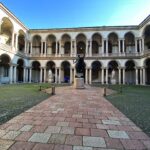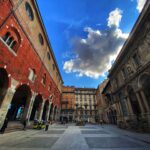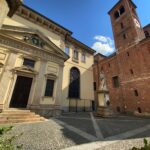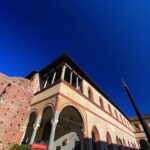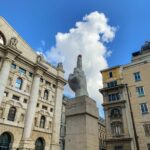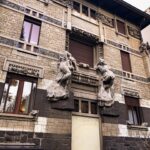Milan’s age-old history allows the visitor, as he is accompanied among monuments and sites, to relive the atmosphere of the ancient Mediolanum, of the Communes and Visconti duchy in the Middle Ages, and of the Renaissance, all the way to today, with the skyscrapers of the contemporary city. Within this section you can find some suggestions to plan your tour.
FROM ROMAN MILAN TO THE INVASIONS
Milan was capital of the Roman Empire from 286 to 402 AD. Few remains are left from that period, like the renowned columns of San Lorenzo and other remains of great value which can be found in churches and museums, but are surely capable of capturing the attention both of the simple visitor and of the scholar. In the Archaeological Museum of Milan there is an impressive scale model of Roman Milan and you can admire the two towers (belonging to the circus and to the city walls) of ancient Mediolanum.
The gold, silver, enamel and ivory objects in the Cathedral Museum and in the Castle Museums are priceless witnesses to the mastery of the goldsmiths of the early Middle Ages. A good example of architecture from this period is the sacellum of San Satiro, which dates back to the 9th century.
MEDIAEVAL MILAN
The best place to capture the atmosphere of the Middle Ages is definitely the basilica of Saint Ambrose, Romanesque but of Roman origin, which houses masterpieces such as the gold altar by Volvinio, the ciborium and the mosaic on the vault of the apse. The basilica was also a workshop in which the Milanese Romanesque style developed, to the point of later becoming a model for other churches in the city.
Other churches which deserve attention are San Nazaro, founded by Ambrose as Basilica Apostolorum and rebuilt in the Romanesque period, and Sant’Eustorgio in Corso di Porta Ticinese, which later began the main church of the Dominican order and which is well known for the relics of the Magi kept inside.
MILAN AND THE RENAISSANCE
If the "signoria" of the Visconti family is mirrored artistically by the construction of the Duomo, it was Francesco Sforza who inherited its legacy. During the period of his duchy the supremacy of Milan was reinforced and the construction of important buildings like the main hospital (Ca’ Granda), now seat of the State University, began. In the years of Ludovico il Moro masterpieces like the sanctuary of Santa Maria presso San Satiro and Santa Maria delle Grazie, along with "The Last Supper", were built. The presence of Leonardo and Bramante made Milan into a true Renaissance court. A tour in the exhibition halls of the Brera Art Gallery, besides the churches and other buildings of the time, can illustrate the contribution of Milan to the arts from 1450 to the end of the century.
MILAN BETWEEN THE 16TH AND THE 17TH CENTURY
After the end of the duchy of Ludovico il Moro and the short period of the French domination, Milan passed under the control of Spain. A key figure of this period was Carlo Borromeo, archbishop of the city and authoritative and authoritarian figure who promoted reforms which deeply affected both the liturgical and the artistic and cultural fields. The new image of the city was reflected by new churches, like San Fedele, and the changes made in the Duomo. Carlo’s cousin Federico Borromeo, who was archbishop of Milan from 1595 al 1631, was the founder of the Biblioteca Ambrosiana, followed by the Pinacoteca Ambrosiana, which was the outcome of his activity as patron and collector.
MILAN IN THE 18TH CENTURY
A new political, administrative and economic phase, characterised by the presence of the Habsburg dynasty, began in the 18th century. Maria Theresa transformed Milan into a small Vienna, and promoted urban and architectural changes, making use of the ability of architects such as Giuseppe Piermarini, who designed the new archducal theatre: but no Milanese ever used that name for it; for us it has always been “La Scala”.
Shortly after, new revolutionary ideals began to spread, and the hopes for a renewal of the relationships between the classes became more concrete. The wave of the French Revolution arrived in Milan also with Napoleon.
MILAN IN THE 19TH CENTURY
With the return of the Austrians, Milan became the capital of the Kingdom of Lombardy-Venetia, however it lived through a very stormy period, characterised by very strong tensions which resulted in the revolts of 1848, the famous Five Days of Milan, which triggered the First Italian War of Independence. Personalities such as the Verri brothers, Carlo Cattaneo and Alessandro Manzoni emerged in the cultural and political life of the city and it was actually in the rooms of the Casa Manzoni, now a museum and studies centre, that one can reconstruct the history of 19th century Milan, through the mementos, documents and writings of our “Don Lisander”.
MILAN IN THE “SHORT CENTURY”
The 20th century opened with two famous deaths: the regicide of Umberto I in 1900 and the death of Giuseppe Verdi in 1901. This was the beginning of a new period in history, in which the enthusiasm of the Avantgarde movements initially led the way, but shortly after came the fear of the war. During World War I the city was left untouched by the conflict, while true devastation occurred during World War II, when the historic centre of Milan was severely damaged by bombing. The years of the reconstruction, feverish and enthusiastic, made Milan the protagonist of the so-called “Italian economic miracle”, with the relaunch of industry. Today’s design furniture and objects, of which Milan is the world capital, bears witness to and is the heir of that favourable conjuncture.
MILAN, 2000 AND BEYOND
New districts and new buildings are changing the city’s skyline. World famous architects and environmental sustainability have become key words for the construction of new buildings next to the historic skyscrapers of the 1950s.
During Expo 2015, whose inauguration was met with some protests, Milan attracted millions of visitors from the whole world and has since become a popular tourist destination, which stands out in elegance, refinement and modernity. All this modernity does not cancel the traces of the past. Starting from these aspects of Milan we begin to talk about our city, its history and its art.

